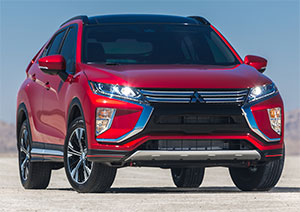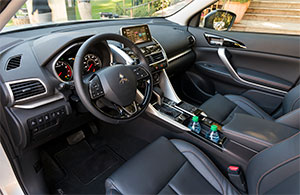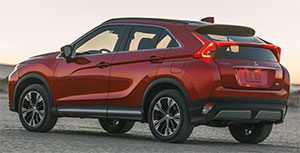2018 Mitsubishi Eclipse Cross
It was the best of times; it was the worst of times. Best, when we heard the rumor that Mitsubishi was bringing back the eclipse; worst, when we found out that wasn’t quite the case, as they’d be using that sporty name on yet another compact crossover. Let’s see if driving the new eclipse cross will put an end to our Dickensian dilemma.
Just when we weren’t too sure about what exactly was going on at Mitsubishi, now that they have aligned themselves with Nissan and Renault, we get word of this new compact crossover, the 2018 Eclipse Cross. Size-wise, it slides in between the Outlander and Outlander Sport in their lineup.
Much like the Honda CRV it would love to steal some sales from, the Eclipse Cross is tiny-turbo-powered with a 1.5-liter I4 rated at 152-horsepower, well short of the CR-Vs 190. There’s more torque, however; 184 lb-ft., compared to Honda’s 179.
Like the CR-V, the Eclipse Cross is CVT tranny only, and base ES trim is the only one available with front-wheel-drive. All other trims come with Mitsubishi’s Super All-Wheel Control all-wheel-drive.
 Those kind of power numbers didn’t exactly peak our anticipation for test track results. Still, the Eclipse Cross doesn’t feel underpowered by any means. It’s a little lazy at launch, but then graceful amounts of power begin pouring on, ushering you to 60 in a respectable 8.6-seconds.
Those kind of power numbers didn’t exactly peak our anticipation for test track results. Still, the Eclipse Cross doesn’t feel underpowered by any means. It’s a little lazy at launch, but then graceful amounts of power begin pouring on, ushering you to 60 in a respectable 8.6-seconds.
The CVT has simulated shifts that help things sound a little less frantic working your way down the track. That all comes to an end in 16.7-seconds at 79 miles-per-hour.
Mitsubishi had to expect some backlash, choosing to resurrect the Eclipse sport coupe’s name on a ute; so they made an earnest attempt to make corner handling worthy of the name.
But a lot of the agility comes from the all-wheel-drive system, which uses selective braking to minimize understeer. Otherwise, we’d call it firmly average; betrayed by safe and slow steering and a fair amount of body roll.
The Eclipse Cross does have all of the features you expect in the modern day compact crossover. Meaning a color multi-information display, steering wheel controls, naturally a backup camera, plus automatic climate; they’re all standard.
Our mid-level SE was outfitted quite nicely, similar to many brand’s top trim levels; and adds a host of comfort and convenience features like heated seats, push button start, and Mitsubishi Connect.
 Unexpected features for this class like head-up display and multi-view camera are also available. Our SE also added advanced safety features like Blind Spot Warning and Rear Cross Traffic alert.
Unexpected features for this class like head-up display and multi-view camera are also available. Our SE also added advanced safety features like Blind Spot Warning and Rear Cross Traffic alert.
The 7-inch infotainment screen shoots out of the dash, and is controlled by a square touchpad controller on the console. There’s a definite learning curve to figure it out, and even once you do, it can be frustrating.
The Eclipse Cross launches a new Mitsubishi Connect subscription service that, in addition to the usual safety notifications, gives you remote access to your car with a cell phone app; allowing you to unlock the doors, change vehicle settings, and even set parental controls.
Seats are sufficiently comfortable, and the general pleasantness of the interior has you wanting to spend plenty of time in the cabin.
The exterior is among its best features; being rather dramatic looking for this usually appliance-like segment.
The front bares a strong resemblance to the Outlander family, and in profile the appearance favors a wedge, but yet a bit more coupish and sporty than most compact crossover rivals.
 The rear is tall, with a split-glass hatch that brings to mind the Pontiac Aztec and the original Honda Insight. While you do see more outside, the split is quite distracting through the rear view mirror.
The rear is tall, with a split-glass hatch that brings to mind the Pontiac Aztec and the original Honda Insight. While you do see more outside, the split is quite distracting through the rear view mirror.
Under the hatch, is a good 22.6 cubic-ft. of cargo space; expanding to 48.9 cubic-ft. with rear seats folded.
All-wheel-drive Eclipse Cross’ have Government Fuel Economy Ratings of 25-City, 26-Highway, and 25-Combined, which we matched almost perfectly with an average of 24.9 miles-per-gallon. Earning an average Energy Impact Score, with the use of 13.2-barrels of oil yearly while emitting 5.7-tons of CO2.
The front-drive Eclipse Cross starts at $24,290, all other trims come with all-wheel-drive and top out with the SEL Touring for $31,390.
While the brand has been on a roller coaster ride here in the U.S., becoming the junior member of the Renault-Nissan-Mitsubishi Alliance has added tremendous stability. And, given that Mitsubishi has a global history of building rugged, dependable, SUVs, we think 2018 Eclipse Cross has a real chance to succeed.
True, by bringing back the Eclipse name, Mitsubishi is clearly aiming to cash in on the Eclipse Coupe’s reputation as a stylish, compact performer that delivers a lot of bang for the buck. We can see many of those same words applying to the Eclipse Cross. So, it might just be exactly what Mitsubishi needs to stay relevant, as they continue to rebuild the brand here and around the world.
Specifications
- Horsepower: 152
- Torque: 184 lb-ft.
- 0-60 mph: 8.6 seconds
- 1/4 mile: 16.7 seconds @79 mph
- EPA: 25 mpg city / 26 mpg highway
- Energy Impact: 13.2 barrels of oil/yr
- CO2 Emissions: 5.7 tons/yr
2024 Polestar 2
More Range And More Power For The Polestar 2
Volvo is well on their way to making the transition to an all-electric brand, but their sister-brand Polestar is already there. Now, we’ve spent lots of time in their all-wheel drive, five-door Polestar 2, having tested it in 2021, and a year later when a two-wheel drive version arrived. But, EV updates are coming quickly. So, let us be your guide for all that’s new with the Polestar 2.
While we are driving more EVs than ever, we’ve also been spending a lot of time recently circling back to ones we’ve previously tested. As in this new era of electrified vehicles, significant updates are arriving quickly, with R&D investments increasing and retrofitting them easier than ever. This is often done through software updates that can even be accomplished over the air. For 2024, the Polestar 2 has indeed gotten some software updates, but some physical ones as well.
Clearly aimed directly at Tesla’s Model 3 when it arrived; the Polestar 2’s build quality was vastly better, but range definitely came up short. So, addressing that was priority No. 1; and for ’24 the Polestar can travel up to 20% farther than before while consuming 9% less energy, and when it comes time to charge it back up, it can do that 34% faster too.
Range in the Single Motor version increases from a max of 270 to 320 miles thanks to a larger 82-kWh battery pack, and that solitary motor now powers the rear wheels, not the front wheels. It’s also bigger, coming in at 220 kW compared to the previous 170 kW front-wheel drive version, going from 231 to 299 horsepower.
Dual Motors keep the same 78-kWh battery, but still sees a boost from 260 to 276 miles and takes advantage of the larger rear motor for a new combined 310-kW output with 421 horsepower. Our test car has the added Performance Pack, which uses an additional 35 kW to deliver 455 horsepower and 546 lb-ft of torque, though max range drops to just 247 miles.
The new battery in rear-drive 2s will also charge faster, now accepting up to 205 kW for an 80% charge in 20 minutes; max for dual-motors stays at 155 kW, which puts an 80% charge at 34 minutes. Using 32 kWh of electricity per 100 miles, the Dual Motor earns a good efficiency rating.
The [Polestar] 2 has always been one of the most enjoyable EVs to drive, even more so now with that additional power coming from the rear motor.
Unfortunately, extremely cold temperatures kept us from seeing that increased range, as we were only on pace for about 194 miles in our test.
The 2 has always been one of the most enjoyable EVs to drive, even more so now with that additional power coming from the rear motor. And especially when equipped with the Performance Pack as it not only includes more power, but adds 20-inch forged wheels, upgraded brakes, and adjustable Ohlins Dual Flow Valve performance dampers. It greatly improves handling prowess without affecting ride quality, and is easily worth the $5,500 charge if you at all enjoy driving.
Even on a 20-degree track day there was plenty of grip through our handling course. No understeer or oversteer, and lots of feedback through the wheel. There was a nice, strong launch off the line that properly planted us firmly in the seat, and rocketed us to 60 in 4.5 seconds. Power delivery stayed pretty intense up until about 80 mph when there was a definite tapering off. Still, it was a 13.4-second quarter-mile at 102 mph; smooth, quiet, and stable the whole way.
When this car debuted, its Google-based infotainment setup was a novelty, but since then, more and more manufacturers are just “Googling it” so it doesn’t seem out of place at all. The wireless phone charger is easy to access, and there’s a great Harmon/Kardon sound system and panoramic sunroof to enhance the in-cabin experience. Exteriors have also been enhanced with a smooth grille insert and new wheel choices.
Hatchback practicality means 14.3 cu-ft of easy to access cargo space with split-folding seatbacks for longer items and expanding the space to 38.7 cu-ft. Plus, there’s even a sizeable storage bin up front under the hood.
Single Motor Polestar 2 pricing now starts at $51,300, with Dual Motors starting at $56,700; topping out at $64,400.
For a car manufacturer that hasn’t even been around for a decade yet, Polestar has kept itself busy, totally transforming their latest model in just a few years, making the 2024 Polestar 2 even more appealing. They are certainly off to a good start, and with a host of Polestars just over the horizon, including some all-important utility vehicles, this star will be shining even brighter.
Specifications
As Tested
- Motor Setup: Dual Motor
- Horsepower: 455
- 0-60 mph: 4.5 seconds
- EPA Range: 247 miles
- Efficiency : 32 kWh / 100 miles
- Battery Size: 78-kWh
- Torque: 546 lb-ft
- 1/4 Mile: 13.4 seconds at 102 mph
- MW Test Loop: ~ 194 miles
- Peak Charging Rate: 155 kW











































